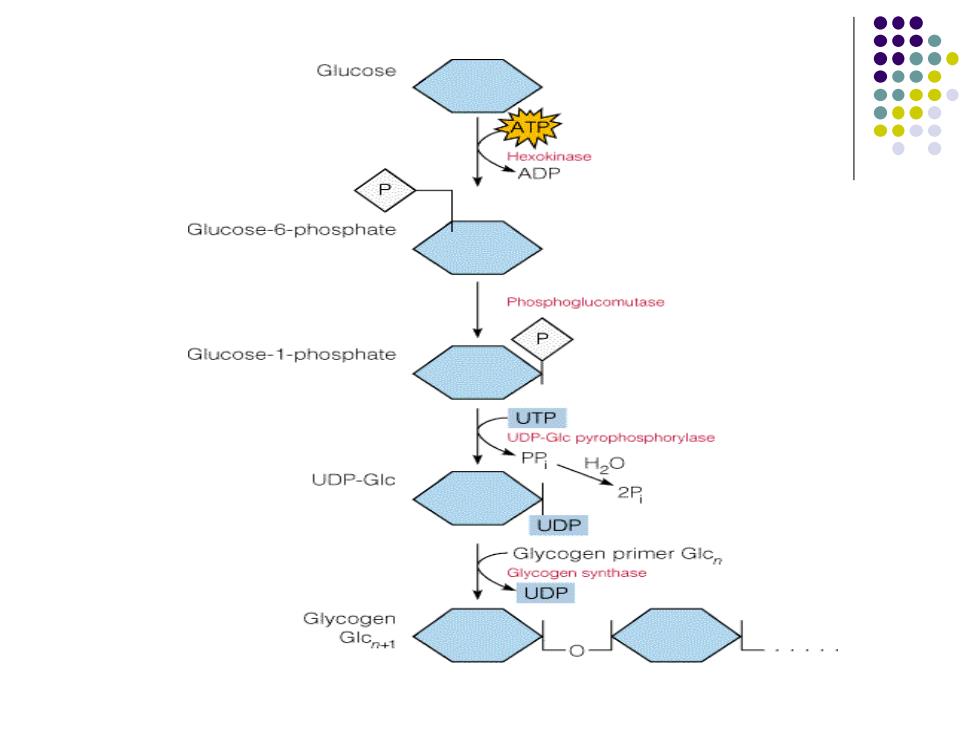
Glucose Hexokinase ADP Glucose-6-phosphate Phosphoglucomutase Glucose-1-phosphate UTP UDP-Glc pyrophosphorylase H.o UDP-GIc 2P UDP Glycogen primer Glcn Glycogen synthase UDP Glycogen GlCn+1
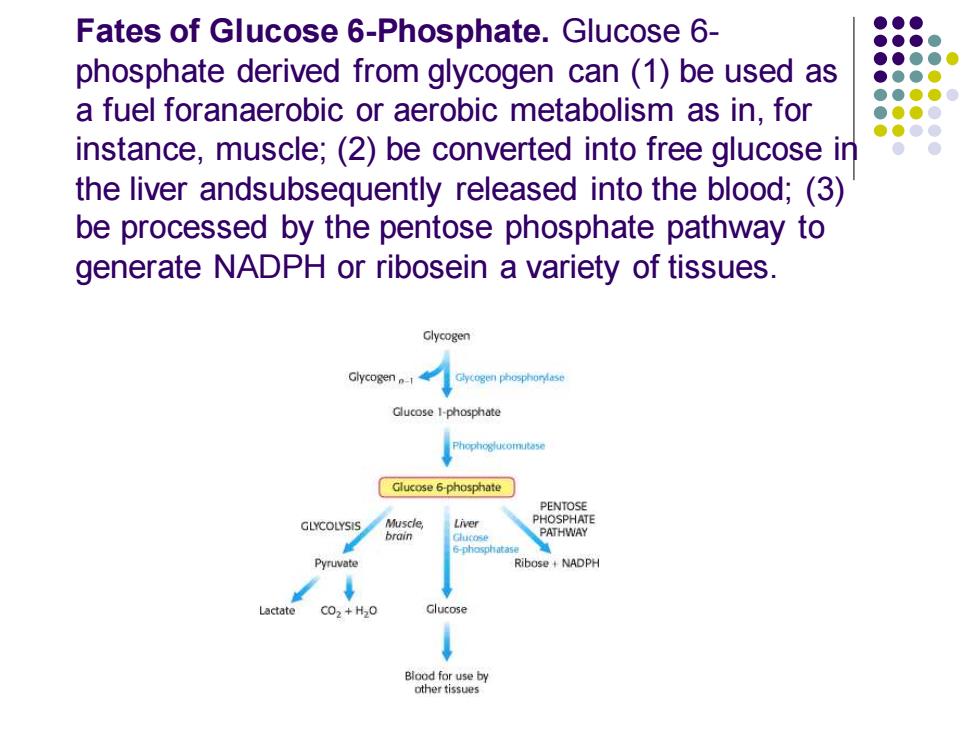
Fates of Glucose 6-Phosphate.Glucose 6- phosphate derived from glycogen can(1)be used as a fuel foranaerobic or aerobic metabolism as in,for instance,muscle;(2)be converted into free glucose in the liver andsubsequently released into the blood;(3) be processed by the pentose phosphate pathway to generate NADPH or ribosein a variety of tissues. Glycogen Glucose 1-phosphate Glucose 6-phosphate PENTOSE GLYCOLYSIS PHOSPHATE PATHWAY Pyruvate Ribose+NADPH Lactate c02+H20 Glucose Blood for use by other tissues
Fates of Glucose 6-Phosphate. Glucose 6- phosphate derived from glycogen can (1) be used as a fuel foranaerobic or aerobic metabolism as in, for instance, muscle; (2) be converted into free glucose in the liver andsubsequently released into the blood; (3) be processed by the pentose phosphate pathway to generate NADPH or ribosein a variety of tissues
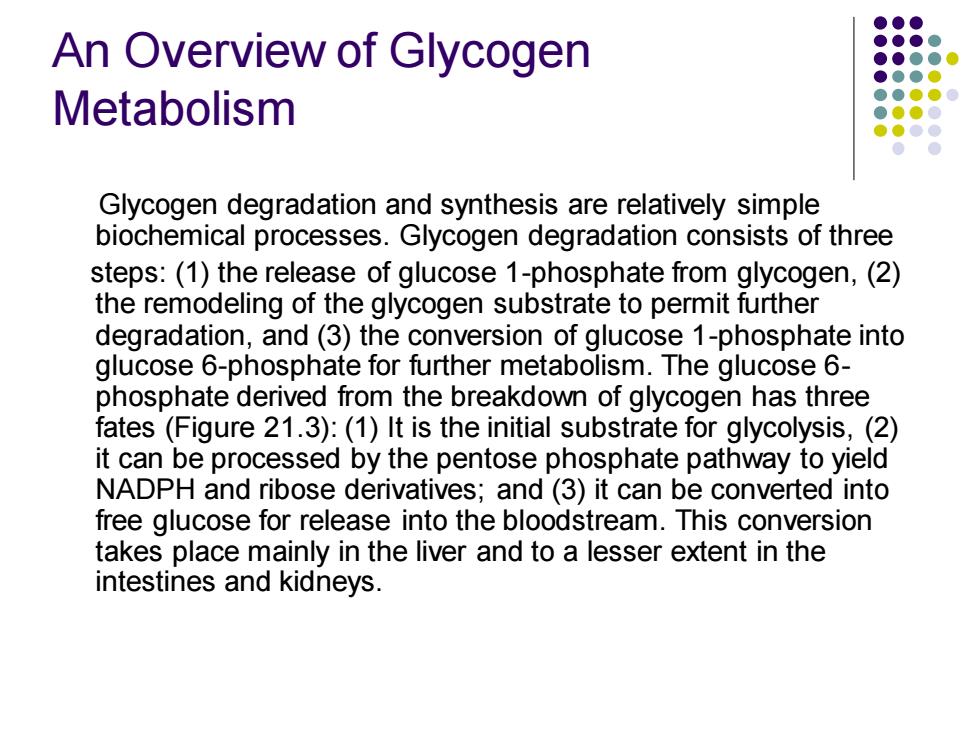
An Overview of Glycogen Metabolism Glycogen degradation and synthesis are relatively simple biochemical processes.Glycogen degradation consists of three steps:(1)the release of glucose 1-phosphate from glycogen,(2) the remodeling of the glycogen substrate to permit further degradation,and(3)the conversion of glucose 1-phosphate into glucose 6-phosphate for further metabolism.The glucose 6- phosphate derived from the breakdown of glycogen has three fates(Figure 21.3):(1)It is the initial substrate for glycolysis,(2) it can be processed by the pentose phosphate pathway to yield NADPH and ribose derivatives;and (3)it can be converted into free glucose for release into the bloodstream.This conversion takes place mainly in the liver and to a lesser extent in the intestines and kidneys
An Overview of Glycogen Metabolism Glycogen degradation and synthesis are relatively simple biochemical processes. Glycogen degradation consists of three steps: (1) the release of glucose 1-phosphate from glycogen, (2) the remodeling of the glycogen substrate to permit further degradation, and (3) the conversion of glucose 1-phosphate into glucose 6-phosphate for further metabolism. The glucose 6- phosphate derived from the breakdown of glycogen has three fates (Figure 21.3): (1) It is the initial substrate for glycolysis, (2) it can be processed by the pentose phosphate pathway to yield NADPH and ribose derivatives; and (3) it can be converted into free glucose for release into the bloodstream. This conversion takes place mainly in the liver and to a lesser extent in the intestines and kidneys
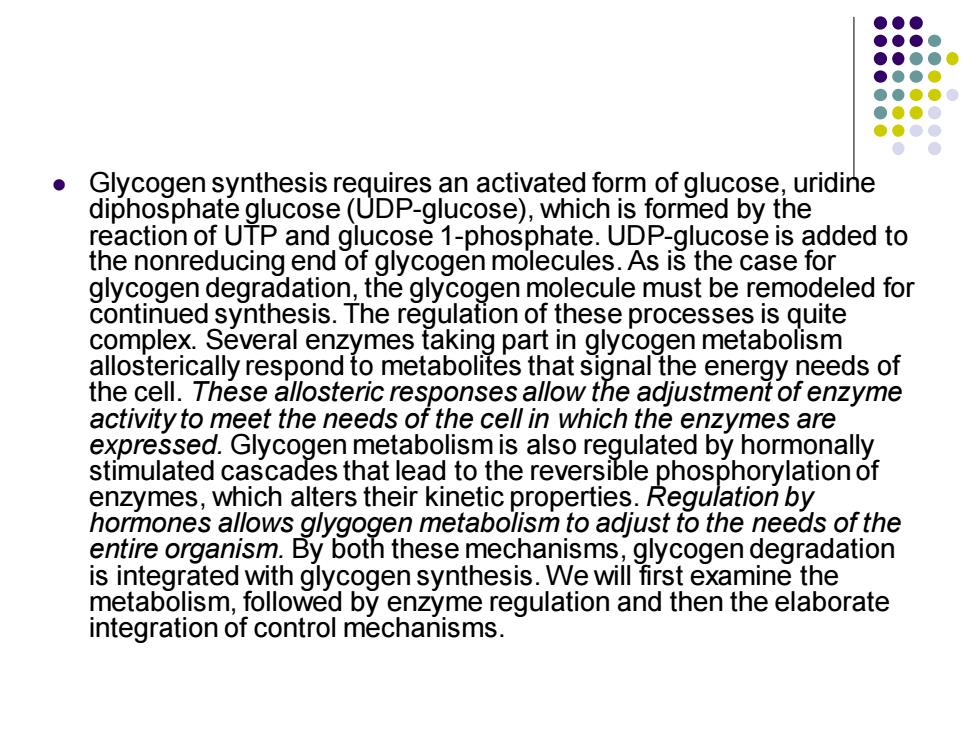
● Glycogen synthesis requires an activated form of glucose,uridine diphosphate glucose(UDP-glucose),which is formed by the reaction of UTP and glucose 1-phosphate.UDP-glucose is added to the nonreducing end of glycogen molecules.As is the case for glycogen degradation,the glycogen molecule must be remodeled for continued synthesis.The regulation of these processes is quite complex.Several enzymes taking part in glycogen metabolism allosterically respond to metabolites that signal the energy needs of the cell.These allosteric responses allow the adjustment of enzyme activity to meet the needs of the cell in which the enzymes are expressed.Glycogen metabolism is also regulated by hormonally stimulated cascades that lead to the reversible phosphorylation of enzymes,which alters their kinetic properties.Regulation by hormones allows glygogen metabolism to adjust to the needs of the entire organism.By both these mechanisms,glycogen degradation is integrated with glycogen synthesis.We will first examine the metabolism,followed by enzyme regulation and then the elaborate integration of control mechanisms
⚫ Glycogen synthesis requires an activated form of glucose, uridine diphosphate glucose (UDP-glucose), which is formed by the reaction of UTP and glucose 1-phosphate. UDP-glucose is added to the nonreducing end of glycogen molecules. As is the case for glycogen degradation, the glycogen molecule must be remodeled for continued synthesis. The regulation of these processes is quite complex. Several enzymes taking part in glycogen metabolism allosterically respond to metabolites that signal the energy needs of the cell. These allosteric responses allow the adjustment of enzyme activity to meet the needs of the cell in which the enzymes are expressed. Glycogen metabolism is also regulated by hormonally stimulated cascades that lead to the reversible phosphorylation of enzymes, which alters their kinetic properties. Regulation by hormones allows glygogen metabolism to adjust to the needs of the entire organism. By both these mechanisms, glycogen degradation is integrated with glycogen synthesis. We will first examine the metabolism, followed by enzyme regulation and then the elaborate integration of control mechanisms
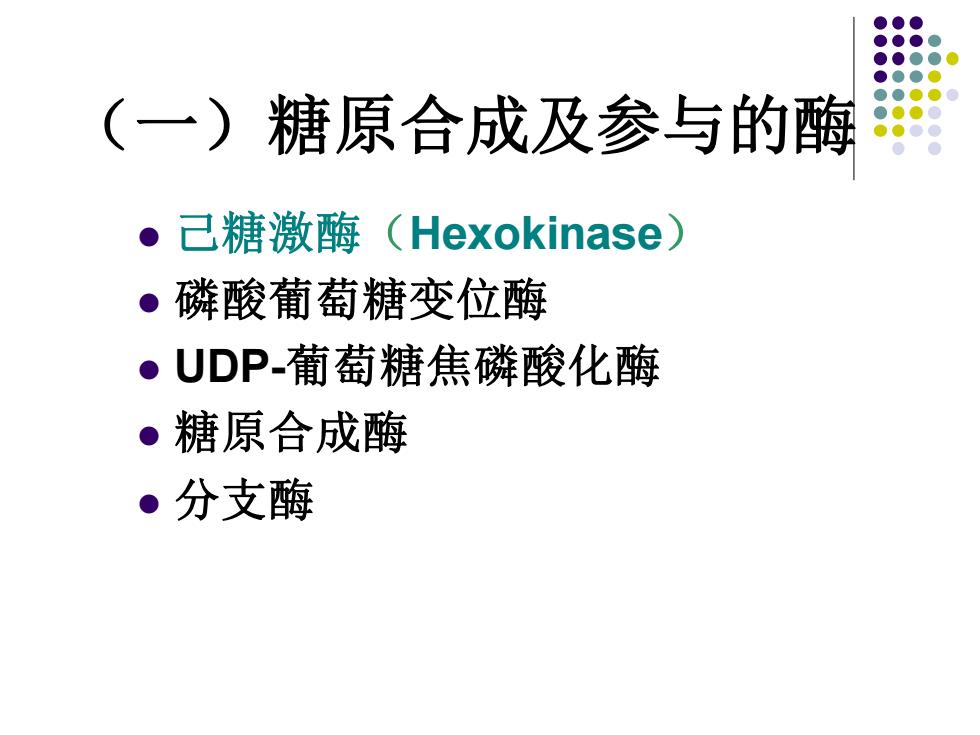
(一)糖原合成及参与的酶 。己糖激酶(Hexokinase) ·磷酸葡萄糖变位酶 ●UDP葡萄糖焦磷酸化酶 ·糖原合成酶 ·分支酶
(一)糖原合成及参与的酶 ⚫ 己糖激酶(Hexokinase) ⚫ 磷酸葡萄糖变位酶 ⚫ UDP-葡萄糖焦磷酸化酶 ⚫ 糖原合成酶 ⚫ 分支酶